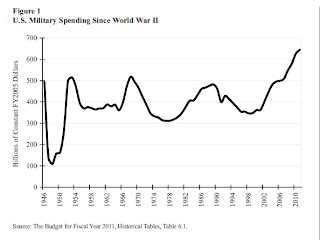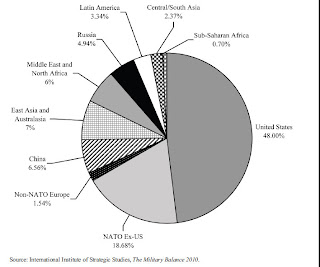How to really cut the deficit
by John MacBeath Watkins
As we've discussed before, most talk about cutting the deficit is just talk, deficit reduction theater with few actual, specific cuts proposed. It's refreshing, then, to find some work that identifies actual cuts and provides logical justification for the policy proposed.
My hat's off to the Cato Institute. I urge you to read this proposal from last September, which I found through Mark Thompson's post on Swampland:
http://timeswampland.files.wordpress.com/2011/02/cato.pdf
Just a few charts from the Cato paper (Budgetary Savings from Military Restraint by Benjamin H. Friedman and Christopher Preble) to whet your appetite (click on the charts to make them larger):
Defense spending is at a post-WW II high. Is our need for defense at a post-WW II high, or did we panic a little after 9/11? We live in a democracy, so the answer is up to us.
The U.S. economy is large -- about 25% of the world's industrial output. Shouldn't our military expenditures be in some way related to that? Do we really need to spend 48% of the world's defense dollars?
Defense spending per capita, in constant 2008 dollars, went from $1,500 per capita in 1998 to about $2,700 per capita in 2008. I'm shocked by those numbers. I realize that this was hidden in plain sight -- Bush kept the cost of two wars off the regular budget with "emergency" spending provisions. But it just isn't that hard to look at the off-budget items and do the math. We're having a huge controversy over government spending, and I would think an 80% increase in per capita spending in one easily-identified sector would have garnered more attention. Instead, we're talking about cutting Social Security, spending on which has increased at nothing like this pace.
The Cato paper proposes $1.2 trillion in cuts by 2020. With that kind of savings, we could all feast on sacred cow.
Of course, first you've got to wind down two wars without making Americans feel as if they've lost. That's the tricky part.
As we've discussed before, most talk about cutting the deficit is just talk, deficit reduction theater with few actual, specific cuts proposed. It's refreshing, then, to find some work that identifies actual cuts and provides logical justification for the policy proposed.
My hat's off to the Cato Institute. I urge you to read this proposal from last September, which I found through Mark Thompson's post on Swampland:
http://timeswampland.files.wordpress.com/2011/02/cato.pdf
Just a few charts from the Cato paper (Budgetary Savings from Military Restraint by Benjamin H. Friedman and Christopher Preble) to whet your appetite (click on the charts to make them larger):
Defense spending is at a post-WW II high. Is our need for defense at a post-WW II high, or did we panic a little after 9/11? We live in a democracy, so the answer is up to us.
The U.S. economy is large -- about 25% of the world's industrial output. Shouldn't our military expenditures be in some way related to that? Do we really need to spend 48% of the world's defense dollars?
Defense spending per capita, in constant 2008 dollars, went from $1,500 per capita in 1998 to about $2,700 per capita in 2008. I'm shocked by those numbers. I realize that this was hidden in plain sight -- Bush kept the cost of two wars off the regular budget with "emergency" spending provisions. But it just isn't that hard to look at the off-budget items and do the math. We're having a huge controversy over government spending, and I would think an 80% increase in per capita spending in one easily-identified sector would have garnered more attention. Instead, we're talking about cutting Social Security, spending on which has increased at nothing like this pace.
The Cato paper proposes $1.2 trillion in cuts by 2020. With that kind of savings, we could all feast on sacred cow.
Of course, first you've got to wind down two wars without making Americans feel as if they've lost. That's the tricky part.



Comments
Post a Comment